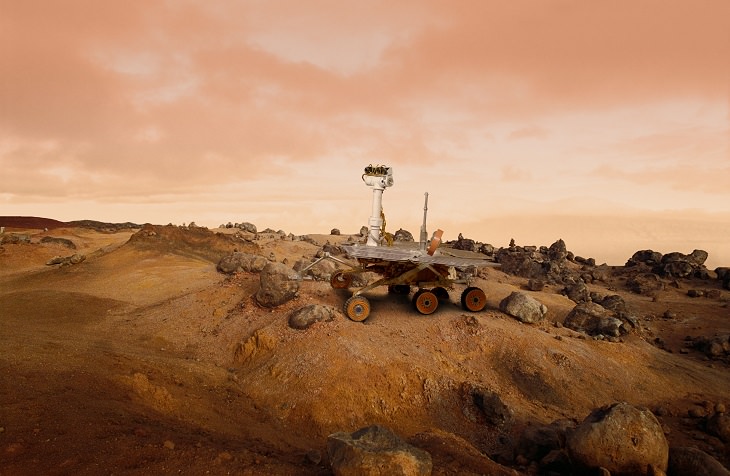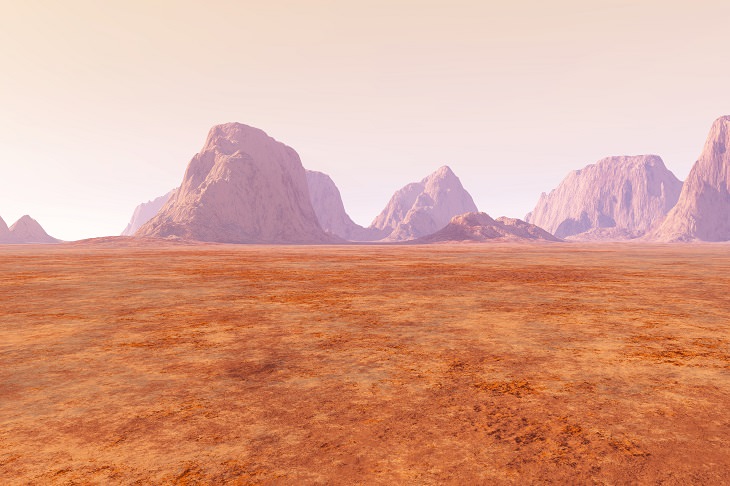
For years, NASA’s Curiosity rover has been gathering samples on the surface of Mars. Recently, their scientists announced that they have discovered conclusive evidence that several organic compounds can be found on the Red Planet.
To add to this, after keeping very close tabs on methane levels in the Martian atmosphere, they have also confirmed that something weird is definitely going on, and they think they know what’s causing it.

A set of geological samples recently delivered courtesy of Curiosity’s drill bit provides us with a deeper understanding of the organic chemistry of the 300-million-year-old mudstone in two different parts of Gale crater.
The samples taken were found to contain thiophene, 2- and 3-methyl thiophene, methanethiol, and dimethyl sulfide. These chemicals probably don’t mean an awful lot to many of us, but to aerologists, it’s an indication that the organic chemistry in Martian mudstone is very similar to that on Earth.
The exciting part is that the method used to detect these chemicals indicates that they’re not floating around in the rock all alone, but are smaller pieces of organic chemistry that have been torn off from even bigger, more complicated materials.
Thomas Zurbuchen, associate administrator for the Science Mission Directorate at NASA Headquarters, says that “with these new findings, Mars is telling us to stay the course and keep searching for evidence of life. I’m confident that our ongoing and planned missions will unlock even more breath-taking discoveries on the Red Planet.”
The other set of results deals with the mysterious case of Mars’ methane. Spikes of methane were first noticed in the Red Planet’s atmosphere a few years ago, drawing intense debate over the hydrocarbon’s possible source.
Data from Curiosity and the Trace Gas Orbiter high above the planet have spotted it in puffs, suggesting that a dynamic process is churning it out in parts per billion. It should take methane around several hundred years to break apart in the presence of UV light, but this is not what’s happening on Mars. The surge in methane seems to fade as quickly as it appears, indicating that there’s not just a variable source, but a methane sink as well.
A new analysis of gather data has confirmed a long-term pattern of methane highs and lows, varying between 0.24 to 0.65 parts per billion. The most exciting news is that the changes definitely match the Martian seasons, hitting a peak at the end of summer in the northern hemisphere.
Here on Earth, 95% of all methane molecules are the product of living organisms. This isn’t to say that there are no non-biological sources, but on our planet, they’re swamped by cow farts and belching bacteria. However, as tempting as it is to suggest that Martian microbes are the source, for now, there are plenty of other candidates to rule out first.

Leading contenders have included some sort of chemical reaction based on a rock known as olivine, meteorites dropping organic materials into the atmosphere, or a release from a sub-surface reservoir close to the surface. These might explain the increase in methane molecules, but they don’t explain the rapid vanishing act.
NASA’s Mars Atmosphere and Volatile Evolution Mission spacecraft effectively ruled out cosmic origins following its analysis of the dust left after a close encounter with the comet Siding Spring in 2014.
A thick stratum of olivine might be a potential contributor, leaking a flow of methane as it reacts with carbon dioxide and water in a process called serpentinisation. The timing of the pulses provides a very important clue.
Alan Duffy, an astrophysicist from Swinburne University in Australia, says that “the seasonal methane peaks in the summer of the Martian northern hemisphere so the source has to be affected by those increasing temperatures from greater sunlight.” A crystalline water structure known as a clathrate provides the perfect explanation. “These clathrates lock the methane inside a water-ice crystal structure and are incredibly stable for millions of years until environmental conditions change and suddenly they can release the gas,” says Duffy.
The inclusion of carbon dioxide in the mix could lower the pressures required to form these lattices, allowing methane clathrates to form just a few meters bellows the surface. Clathrates don’t explain the origins of the methane molecules themselves, but their involvement would go a long way to explaining yearly shifts in methane levels.
As winter starts, the gases are once again trapped in ice cages, helping to explain why some of the methane suddenly vanishes.
So, where does the methane come from in the first places? Serpentinisation is still on the cards, as are minute traces delivered by asteroids, and other chemical processes. Some sort of life form can’t be ruled out, but any kind of complex organic chemistry would still tell us something about how life arose on Earth.
At this moment in time, there’s just no way of knowing whether the organic molecules and the methane findings point to potential life on Mars. Future testing of carbon isotopes in the methane could help to make the picture clearer, but for now, we cannot get too carried away – although the new results are a massive step towards finding out even more.
Source: sciencealert
Images: depositphotos